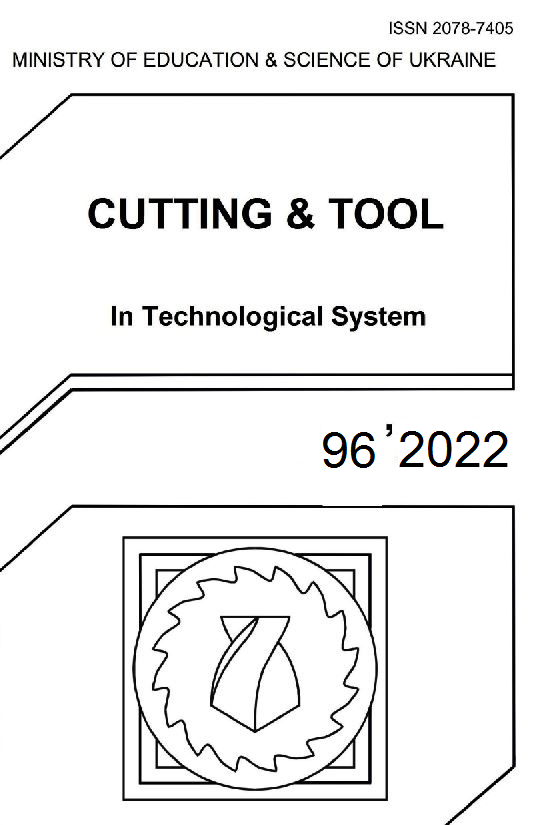METHODOLOGY FOR DEVELOPING AN EXPERT SYSTEM FOR THE GRINDING OF SUPERHARD MATERIALS
DOI:
https://doi.org/10.20998/2078-7405.2022.96.09Keywords:
Diamond grinding wheel, Finite element method, Knowledge base and database, grinding process optimization, grinding rate, Stress-Strain State, Tool Sharpening, Surface RoughnessAbstract
An expert system of the grinding process has been developed, which makes it possible to predict and optimize the process of defect-free processing of both existing and newly created superhard materials. The expert system consists of two interconnected modules - theoretical and experimental. The theoretical module of the expert system allows, at a given level of significance, to determine the values of the output indicators and the kinetics of their change in the process of adaptability, depending on the physical and mechanical properties of the interacting materials and processing conditions. The experimental module of the expert system allows you to coordinate and correct the results of theoretical calculations when determining the optimal grinding and operating conditions for processing various grades of superhard materials. When optimizing the sharpening process of a blade tool, processing efficiency, consumption of diamond wheels, cost price and various quality indicators of its cutting elements can be selected as a criterion. The use of the expert system significantly reduces the amount of expensive and laborious researches in determining the optimal processing conditions for various grades of superhard materials (SHM), including newly created ones.
References
Waterman D. A guide to expert systems / Transl. from Eng. - M.: Mir, 1989. - 369 p.
Fedorovich V.A. (2002) Elaboration of scientific fundamentals and methods of practical realization of adaptability control at diamond grinding of superhard materials: Thesis, Doct. Techn. Sc.: 05.03.01. Kharkov, 469 p.
Grabchenko, A., Fedorovich V., Pyzhov I., Babenko E., Klimenko V.: Simulation of Grinding Process of Polycrystalline Superhard Materials. In: Key Engineering Materials, Vol. 581, pp. 217 – 223, (2014). Trans Tech Publications, Switzerland.
Mamalis A.G., Grabchenko A.I., Fedorovich V.A., Kundrák J.: Methodology of 3D simulation of processes in technology of diamond-composite materials. In: International Journal Of Advanced Manufacturing Technology, Vol. 43, Issue: 11-12, pp. 1235 – 1250, DOI: 10.1007/s00170-008-1802-0 (2009).
Novikov N.V., Maistrenko A.L., Kulakovsky V.N. Resistance to fracture of superhard composite materials. - Kiev: Nauk. dumka, 1993.—220 p.
Wang J.M., Tong F.Y., Li XX (2013) 3D Dynamic Finite Element Simulation Analysis of Single Abrasive Grain during Profile Grinding with Axial Feed. Advanced Materials Research 680: 410-416 DOI 10.4028/www.scientific.net/AMR.680.410
Mamalis, A.G., Grabchenko, A.I., Fedorovich, V.A.,, Paulmier, D., Horvath, M.: Development of an expert system of diamond grinding of superhard polycrystalline materials considering grinding wheel. In: International Journal of Advanced Manufacturing Technology, 17(7), рp. 498 – 507, (2001).
Kundrák, J.,, Fedorenko, D.O., Fedorovich, V.О., Fedorenko, E.Y., Ostroverkh, E.V.: Porous diamond grinding wheels on ceramic binders: Design and manufacturing. In: Manufacturing Technology, Vol. 19, No. 3, pp. 446 – 454, (2019).
Mamalis A.G., Grabchenko A.I., Fedorovich V.A., Kundrak J, Babenko E.A. (2012) Ways of simulation-based improvement in the performance of diamond-abrasive tools. Journal of Machining and Forming Technologies 4: 1-11 53.
Dobroskok V.L. Scientific foundations of the formation of the working surface of wheels on conductive bonds in the process of grinding: Disс...Doc. of engineering: 05.03.01 - Kharkov, 2001. – p. 447.
Fedorovich V.A. Controlling the parameters of the submicrorelief of diamond grains when grinding superhard materials // Vysoki tekhnolohii v mashynobuduvanni: Collection of scientific articles NTU "KhPI". - Kharkiv. - 2001.- Ed. 1(4). - pp. 50-54.
Downloads
Published
Issue
Section
License
Copyright Notice
Authors who publish with this Collection agree to the following terms:
1. Authors retain copyright and grant the Collection right of first publication with the work simultaneously licensed under a Creative Commons Attribution License that allows others to share the work with an acknowledgement of the work's authorship and initial publication in this Collection.
2. Authors are able to enter into separate, additional contractual arrangements for the non-exclusive distribution of the Collection's published version of the work (e.g., post it to an institutional repository or publish it in a book), with an acknowledgement of its initial publication in this Collection.
3. Authors are permitted and encouraged to post their work online (e.g., in institutional repositories or on their website) prior to and during the submission process, as it can lead to productive exchanges, as well as earlier and greater citation of published work.

